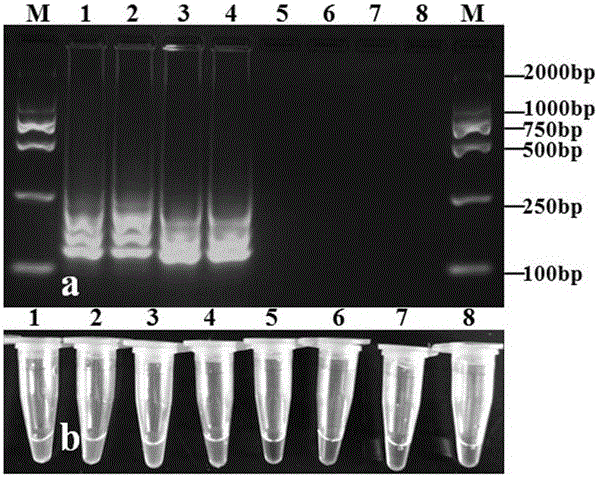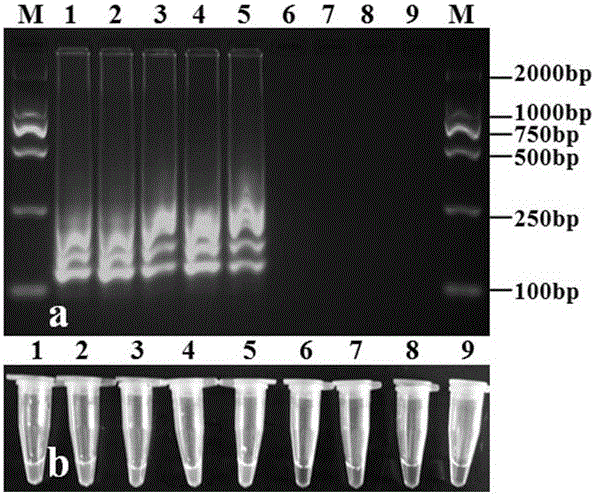Phytophthora colocasiae LAMP (loop-mediated isothermal amplification) detection primer and detection method
A loop-mediated isothermal and detection method technology is applied in the fields of identification and control, and crop disease detection, which can solve the problems of long detection time, cumbersome procedures and low accuracy, and achieve reliable results, high sensitivity and good practicability. Effect
- Summary
- Abstract
- Description
- Claims
- Application Information
AI Technical Summary
Problems solved by technology
Method used
Image
Examples
Embodiment 1
[0035] Example 1: Design of specific primers for the detection of Phytophthora colocatus Loop-Mediated Isothermal Amplification (LAMP) and the specificity verification of the primers
[0036] 1. Extraction of genomic DNA of the tested strains
[0037] The genomic DNA of the tested strain (Table 1) was extracted by the CTAB method. The specific method was as follows: Take a small amount of mycelium powder in a 1.5 mL centrifuge tube (it is better that the mycelium powder just covers the bottom of the semicircle), add 900 µL of 2% CTAB ( cetyltrimethylammonium bromide) extract (2% CTAB; 100 mmol / L Tris-HCl, pH 8.0; 20 mmol / L EDTA, pH 8.0; 1.4 mol / LNaCl) and 90 µL SDS (ten Sodium dialkylbenzene sulfonate) [Note: CTAB, SDS needs to be preheated at 60°C], use a shaker to shake and mix, 60°C water bath for 1h (DNA is released into the buffer), 12000 r.min -1 Centrifuge for 15 min; take 700 µL of the supernatant, add an equal volume of phenol, chloroform, isoamyl alcohol mixture (vo...
Embodiment 2
[0053] Example 2: Determination of Sensitivity of Phytophthora taro Loop-Mediated Isothermal Amplification (LAMP) Detection
[0054] 1. Preparation of genomic DNA at different concentrations
[0055] Phytophthora taro genome DNA is diluted with sterile ultrapure water, and prepared into a series concentration of 10 times order of magnitude for subsequent use;
[0056] 2. Sensitivity determination and result observation of LAMP detection method
[0057] Using different concentrations of Phytophthora colocasia genomic DNA as a template, the outer primers PcoF3 / PcoB3 and inner primers PcoFIP / PcoBIP were used for LAMP amplification. The LAMP detection reaction system was 25 μL, including 5 μM outer primers PcoF3 and 1.0 μL each of PcoB3, 40 μM inner primer PcoFIP and PcoBIP each 1.0 μL, LAMP reaction mixture [40 mM Tris-HCl, 20 mM (NH 4 ) 2 SO 4 , 20 mM KCl, 16 mM MgSO 4 , 1.6 mol / L Betaine (Betaine), 2.0 mMdNTPs, 0.2% Trion X-100] 12.5 μL, 8 U Bst 1.0 μL of polymerase, 1.0 μ...
Embodiment 3
[0060] Example 3: LAMP detection of Phytophthora taro in diseased leaves of taro
[0061] Sample collection: Collect leaves with typical symptoms of taro blight and healthy leaves from Fuzhou, Xiapu, and Fuding in Fujian and bring them back to the laboratory for later use;
[0062] Extraction of Phytophthora taro DNA from diseased leaves: DNA was extracted by NaOH rapid cleavage method, the specific process was as follows: Add 10 µL 0.5 mol / L NaOH to each mg of plant tissue, fully grind the tissue into a paste in a mortar, and then transfer to Centrifuge at 12,000 rpm for 6 min in a 1.5 mL centrifuge tube, take 5 µl of the supernatant and add 495 µL of 0.1 mol / L Tris-HCl (pH=8.0) to mix well, and take 1.0 µL as a PCR template for amplification.
[0063] LAMP amplification detection and observation: Using the above-mentioned extracted DNA as a template, use the outer primer PcoF3 / PcoB3 and inner primer PcoFIP / PcoBIP for LAMP amplification. The LAMP detection reaction system is ...
PUM
| Property | Measurement | Unit |
|---|---|---|
| Sensitivity | aaaaa | aaaaa |
Abstract
Description
Claims
Application Information
 Login to View More
Login to View More - R&D
- Intellectual Property
- Life Sciences
- Materials
- Tech Scout
- Unparalleled Data Quality
- Higher Quality Content
- 60% Fewer Hallucinations
Browse by: Latest US Patents, China's latest patents, Technical Efficacy Thesaurus, Application Domain, Technology Topic, Popular Technical Reports.
© 2025 PatSnap. All rights reserved.Legal|Privacy policy|Modern Slavery Act Transparency Statement|Sitemap|About US| Contact US: help@patsnap.com



